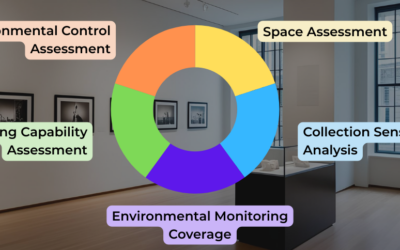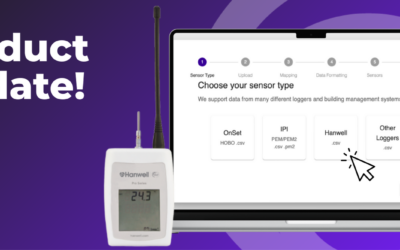If you are planning to loan your artworks or collections to another institution for an exhibition, you know you need to consider the environmental conditions that they will be exposed to. Environmental monitoring is a crucial part of collections care, as it helps to prevent or mitigate damage caused by factors such as temperature, humidity, light, pollutants, pests, and vibrations. In this post, we will discuss some of the best practices for environmental monitoring when loaning your collections, and what to include in your art exhibition loan agreement.
Establish the environmental requirements for your collections
Before you agree to loan your collections, you should determine the environmental requirements for each item or group of items. These requirements may vary depending on the type, age, material, condition, and sensitivity of the collections.
You can always consult the free guidelines and standards from reputable organizations such as the American Institute for Conservation (AIC), the International Institute for Conservation of Historic and Artistic Works (IIC), the International Council of Museums (ICOM), and the Canadian Conservation Institute (CCI) for reference.
You may also document the current environmental conditions of your collections and their storage or display areas to compare for any differences. Remember that the more similar the conditions are, the less likely your collections will be shocked by the changes.
Negotiate the environmental terms in your art exhibition loan agreement
First of all, don’t forget that accessibility and sustainability are key concepts for 21st century collection loans. Unrealistic environmental requirements in loan agreements remain one of the biggest barriers to moving collections as they are expensive to set and maintain. Make sure you read up on some of the latest conference proceedings and research on evidence-based decision-making for loan agreements before setting your final requirements.
Once you have established the environmental requirements for your collections, you should negotiate them with the borrowing institution and include them in your art exhibition loan agreement. The agreement should specify the acceptable ranges and limits for each environmental factor, as well as the frequency and methods of monitoring and reporting. The agreement should also state the responsibilities and liabilities of both parties in case of any environmental issues or damage to the collections.
Who do you contact, or who will contact you when, if environmental conditions shift unfavorably? What is the maximum amount of time that should pass before someone responds to your concerns? What actions should be taken to rectify a situation? Who will pay for an emergency response? How will this be covered by the insurance policy? You should review and approve the environmental conditions of the borrowing institution before signing the agreement.
Although not directly related to the environmental conditions, make sure you include other important information in your final agreement such as detailed object condition reports, length of the loan, clear descriptions of all conservation requirements (like packing or special handling instructions), requirements for emergency situations and insurance as well as the limits on remedial conservation. In other words, what is explicitly allowed or not allowed during an interventive treatment at the borrowing institution. Read more about art exhibition loan agreements in this guideline by AIC’s conservation Wiki.
Monitor the environmental conditions during transit and exhibition
After you have signed the art exhibition loan agreement, you should monitor the environmental conditions during transit and exhibition of your collections. You can use various tools and devices such as wireless data loggers, hygrometers, thermometers, light meters, and pest traps to measure and record the environmental data.
Make sure you inspect your collections regularly for any signs of deterioration or damage and communicate with the borrowing institution to report any deviations or problems as soon as possible. You should also document the environmental conditions and any incidents or interventions that occur during transit and exhibition. A dedicated environmental monitoring platform which allows you to add observations and get real-time alerts can be a valuable tool for this kind of activity during loans.
Conserv allows you to define “levels,” which are our environmental parameters or as we like to call them, “goal posts,” for where you’d ideally like the environment to be. You can set these levels to whatever your loan says. Conserv Cloud’s included reporting capabilities will then tell you what % of the time you are within the levels you have determined over any specified period of time. You can easily take this and share it with your lender!
There are three different reports within Conserv Cloud:
- In-Depth Report – this is the most customizable report, and it can be built directly within the analytics portion of the software. The report will be based directly on what is being visualized at the time of its creation, so be sure to select the correct spaces, dates, aggregation, and readings that you want before generating the report.
- Performance Report – This is a higher level report that will show the key performance indicators (KPI’s) for all the spaces. You can access this report from the “Reports” tab on the left side of your screen.
- Facilities Report – This report enables you to export the environmental data you need in the correct format to complete an AAM (American Alliance of Museums) General Facility Report to send to lenders. Not everyone will need this, but those who do will be happy!
Evaluate the environmental impact on your collections after they return
When your collections come back to you after the exhibition, you should make new condition reports and compare them with the ones that were made before the exhibition. And don’t forget to quarantine your objects just in case before you place them back with the rest of your collections! The last thing you need is an unexpected pest infestation in your storage spaces.
If this hasn’t been done in real-time or periodically during the loan, review all the environmental monitoring information provided by the borrower. In the unlikely event that the objects return with visible damage caused by environmental conditions during their trip outside your institution, you should be able to identify these conditions in the monitoring reports. If necessary, follow up with the borrowing institution if there are any unresolved issues or disputes regarding the environmental conditions or damage to your collections.
Review and improve preventive conservation measures for future loans
After a successful collections loan, consider implementing preventive conservation measures for future loans based on your experience and evaluation. Review and update your environmental requirements and policies for your collections and ensure that they are consistent with current recommended practices and the condition of your objects.
Evaluate what went well and what didn’t and tweak your future practices to take into account your growing experience. If necessary, upgrade or improve your environmental monitoring methods and tools and train your staff on how to use them effectively.
Conclusions
What’s the purpose of a loan agreement? Essentially, you are trying to make sure that all possible situations are foreseen and that responsibilities for the objects are clearly drawn. With both an owner and a borrower, the last thing you need is to be throwing a ball around when collections are at risk and important decisions need to be made in a timely manner.
During a loan, you want to make sure you avoid accidental overstepping of boundaries regarding conservation interventions. You also want to be able to call in the insurance if something goes wrong at any point during all the steps required to move a collection to a new place and mount it into an exhibition. There are so many opportunities for things to go wrong that it’s essential to have a document which attempts to prevent negative situations from arising and outlines clear procedures when they cannot be avoided.
Above all, don’t forget that art exhibition loan agreements are created and carried out by well-intentioned but flawed humans. Work on establishing a good relationship with potential borrowing institutions and collaborate with them on environmental monitoring and collections care. It is better to treat a loan as a joint team effort rather than an us versus them institutional debate. Having great documentation, trusting your peers, communicating clearly and politely, and being transparent with important information will greatly improve your loan experience.
If you still have doubts about art exhibition loan agreements or the environmental monitoring necessary during loans to comply with your agreements, don’t be afraid to write a post in the Conserv Community. There are over 300 collections care professionals there with joint centuries of experience to help you out!
If you have any questions about environmental monitoring, integrated pest management, or just want to talk about preventative conservation, please reach out to us! Don’t forget to check out our blog or join our community of collections care professionals where you can discuss hot topics, connect with your peers or even take a course to get familiar with the Conserv platform.





